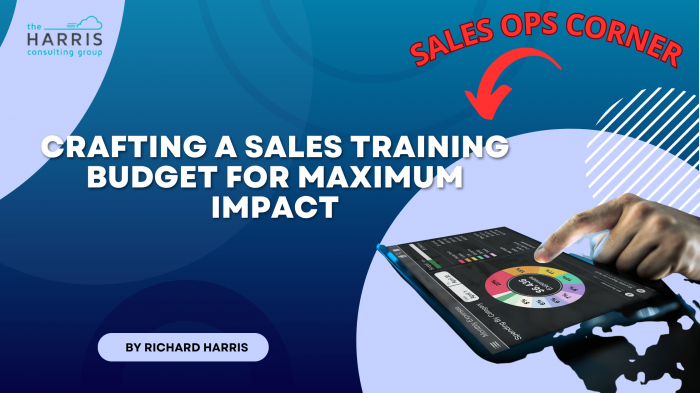Setting budgets, especially for sales training, is currently a significant challenge in any sales team today. As sales teams (including sales ops) adapt to changing market dynamics, the need for effective sales training becomes paramount. In this comprehensive guide, we will delve deep into strategies for setting a sales training budget. My aim is to equip you with a detailed roadmap for creating a meaningful sales training budget that ensures maximum returns on your investment and also leaves your team saying, “Wow. Sales leadership really knew what the hell they were doing!”
Key Questions and In-Depth Tips for Setting Your Sales Training Budget:
Question 1: Is the training budget % of the total salaries of SDR/AE? Would love to hear how you have structured it internally. (e.g., $X/year/SDR)
Tip 1: Define Clear Training Skill Improvements Needed
When embarking on a sales training initiative, set clear and specific objectives tied to measurable outcomes. Break down goals into concrete components, such as enhancing cold outbound, negotiation training, email prospecting, gatekeeper interactions, and so on.
These specific objectives provide a solid foundation for measuring training success and will help any objection handling from your CRO.
- Step 1 – Define your sales team’s specific needs and pains.
And if you know me, you know I hate buzzwords so here is how to go beyond the buzzwords. –
“At the end of the sales training, we expect the team to be better at ___, ___, and ___.
And if you say things like discovery, negotiations or closing skills you need to dig even deeper. Think in a use-case mindset.
*When we say improving discovery skills, we mean ___, ___, and ___. When we say improving negotiation skills, we mean ___, ___, and ___.
When we say improving closing skills, we mean ___, ___, and ___.
* Tip – Ask 1-2 of your top reps, and your VP of Sales/ CRO, and CEO the same initial question. At the end of the sales training, we want the team to get better at ___, ____, and ___. Do this in a vacuum, not a Reply All email. When you get the answers from those above you, your answers, and the answers from your salespeople. You now have a great visibility of where the sales skills gaps truly exist. **
Tip 2: Metrics Matter – Digging Deeper:
Evaluate the impact of sales training with robust metrics that reflect improvements in key areas. Consider metrics related to lead generation, meeting quality, pipeline qualification, conversion rates, and customer acquisition costs.
Analyze the performance of each sales representative individually and as part of the team, identifying top performers and areas for improvement.
Salespeople with greater sales skills had higher revenue and greater customer satisfaction. Depending on the organization, between 17% and 67% of the differences between high and low performers is attributable to differences in these skills. *
- Source “Sales as a source of competitive advantage” (https://global.wilsonlearning.com/resources/sales-competitive-adv/)
Step 2 – Define specific sales success metrics and kpis.
- We will claim that success will be an increase (or decrease) in ___, ___, and ___.
Often times its about an increase in the sales pipeline. Ironically it can also mean a decrease in the sales pipeline but an increase in pipeline quality. when you first start.
Once a sales rep gets better at discovery, they will no longer allow fluff in the pipeline. And, after training, its very normal for a lot of deals that are in the pipeline to be wiped out because they never should have been there in the first place.
Just remember, a decrease in new pipeline growth is not always a bad thing. We don’t have to like it of course, its simply something to be considered.
- Step 3 – Confirm you baseline
True or Fales – We have a baseline of ____ and ____ where we can start?
If True, then good, move forward.
If False, hold your horses. You will now need to make a decision about getting enough data to establish a baseline.
If you do not already have a realistic, I repeat, a realistic pipeline then you will have to commit to the following statement.
Since we do not have a strong baseline we will give ourselves ____ months to gather baseline data.
If you think running the experiment with 1-2 months of data will give you a baseline you are simply rationalizing an irrational belief. In short, you are lying to yourself.
We understand that in today’s economic environment and desire to grow pipeline and sales revenue you want to move fast. Newsflash fo you, it doesn’t matter how fast you want to move, it only matters how accurately you move.
Tip 3: Data-Driven Insights for Optimal Budget Allocation:
Allocate a larger portion of the budget to training modules that directly address identified weaknesses.
Continuously monitor and adjust budget allocation based on real-time performance metrics to ensure that resources are allocated where they are needed most.
As you look to define your budget, it’s always recommended that the cost be measured against the LTV of each new customer. Not just the first-year ACV. This is where you can explain the the CEO and CFO that the company as a whole benefits from new clients and that they should be paying the same amount of attention to the Customer Success and retention teams as it relates to customer churn and Net Revenue Retention.
It also puts fair pressure on the executive team to own the whole number in a way they usually do not think. It shows them that sales is not a turnkey role, responsibility or team.
Question 2: How is the budget divided between software products vs coaching agencies/third-party training?
Tip 4: Tailor Learning Approaches to Individual Needs:
Recognize that each sales team member may have unique learning preferences.
Offer a mix of online training solutions, in-person coaching, and mentorship programs to cater to various learning styles.
Leverage technology for self-paced learning while ensuring customization for specific team needs
Tip 5: Cost vs. Customization – Striking the Right Balance:
Assess the advantages and disadvantages of software-based training versus coaching agencies and third-party training programs.
Consider the scalability and cost-effectiveness of software solutions, balanced with the customization and personal touch offered by coaching agencies.
Aim for a balanced approach that combines the strengths of both to create a comprehensive training ecosystem.
Tip 6: Reinforcement Matters:
Ensure that your training budget includes post-training reinforcement sessions.
Reinforcement is critical for long-term retention and application of training concepts.
Factor in ongoing coaching and mentoring to solidify training outcomes and promote continuous improvement.
Question 3: How do you define the ROI of these activities? (Given they have a 2nd-degree effect on revenue)
Tip 7: Economic Impact – A Holistic Approach:
Nobody ever believes the R, they only see the I. ALWAYS!
ROI is a TERRIBLE term. It is merely a scare tactic that is used against the champion of the deal internally as well as the salesperson who is trying to sell.
Shift the focus from traditional ROI measurement to demonstrating the economic impact of sales training.
Calculate the economic impact by showcasing metrics like increased pipeline growth, close ratios, the lifetime value (LTV) of new businesses, and customer retention rates.
Track how training affects not only immediate revenue but also long-term customer lifetime value, helping to secure a stable revenue stream.
Tip 8: Articulating the Economic Impact:
Emphasize the broader economic implications of your training initiatives.
Showcase how well-trained sales teams can contribute to overall business growth, market share expansion, and competitive advantage.
Present a compelling narrative that connects training investments to the organization’s financial health and long-term sustainability.
Challenges and Capitalizing on Trends:
Tip 9: Sales Team Accountability – A Key to Success:
Articulate that the economic impact depends on the entire sales team’s ability to execute and close deals.
Implement mechanisms for continuous performance evaluation and accountability, including regular performance reviews and performance improvement plans.
Foster a culture of ownership and responsibility within the sales team, where each member understands their role in achieving success.
Tip 10: The Human Touch in a Digital World:
In an increasingly digital sales landscape, remember the importance of personal relationships.
Train your sales team to excel in both digital and interpersonal aspects of sales, emphasizing the value of building genuine connections with customers.
Leverage technology for automation and efficiency while preserving the art of relationship-building as a differentiating factor in the sales process.
Tip 11: Leveraging Training for Market Adaptation:
Consider using training as a tool for rapid adaptation to changing market conditions.
Allocate budget resources for specialized training modules that address emerging market trends, including digital marketing strategies, virtual selling techniques, and remote collaboration tools.
Stay ahead of the curve by ensuring your sales team is well-equipped to respond swiftly and effectively to market shifts.
Tip 12: Employee Development and Retention:
Recognize that investing in training also enhances employee satisfaction and retention.
A well-trained sales force is more likely to stay with your organization, reducing turnover costs and preserving institutional knowledge.
Highlight this dual benefit when justifying your training budget to decision-makers, emphasizing the positive impact on talent retention and organizational stability.
Explore more insights and resources at The Harris Consulting Group to accelerate your sales growth. We invite you to actively participate in shaping the future of sales excellence and share your experiences and insights within our community.
Your input and collaboration are essential as we navigate the ever-evolving landscape of sales training and success. Feel free to join in on the conversation on Linkedin, in my blog, or shoot me an email.







